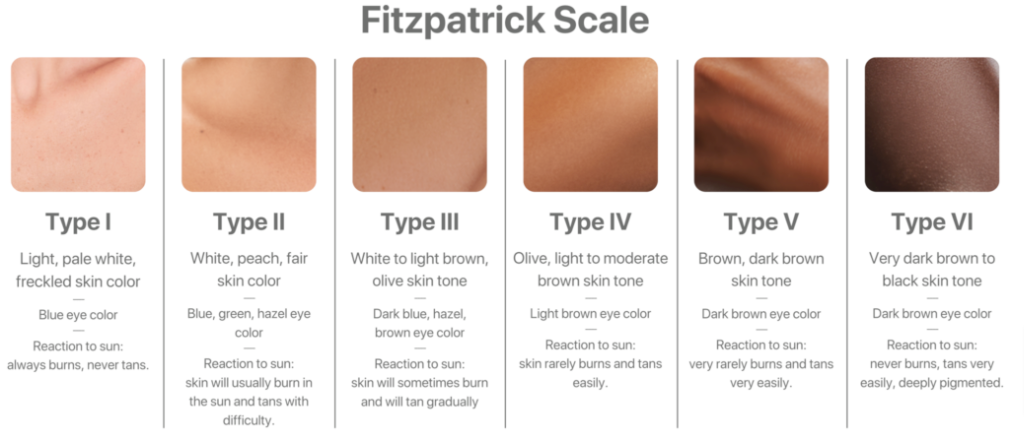When considering aesthetic treatments such as laser procedures, microneedling, or chemical peels, understanding your skin type is essential. The Fitzpatrick Scale, developed in 1975 by dermatologist Thomas Fitzpatrick, categorizes skin based on how it reacts to sun exposure and treatments. This classification helps aesthetic providers tailor treatments for safety and effectiveness while minimizing risks such as burns, pigmentation changes, or adverse reactions.

Why the Fitzpatrick Scale Matters in Aesthetic Services
The Fitzpatrick Scale is used across dermatology and aesthetic medicine to determine how skin will respond to laser treatments, IPL, radiofrequency microneedling, and chemical peels. Since different skin types react differently to heat, light, and chemical exfoliants, aesthetic providers must adjust treatment settings accordingly to prevent complications like hyperpigmentation, hypopigmentation, or burns.
Using this scale, aesthetic professionals can safely customize treatments for optimal results, ensuring patients receive treatments suitable for their unique skin type.
The Fitzpatrick Skin Type Classification
The Fitzpatrick Scale divides skin into six types, based on melanin content and UV sensitivity:
Fitzpatrick Skin Type I
- Characteristics: Very fair, pale skin; often with red or blonde hair and blue, green, or gray eyes.
- Reaction to Sun: Always burns, never tans.
- Risk Factors: High risk of sun damage, skin cancer, and irritation from aggressive treatments.
- Aesthetic Considerations:
- Best Treatments: Laser treatments (at lower energy settings), microneedling, and chemical peels.
- Caution: Requires diligent sun protection before and after treatments to avoid complications.
Fitzpatrick Skin Type II
- Characteristics: Fair skin, often with light eyes and blonde or light brown hair.
- Reaction to Sun: Burns easily, tans minimally.
- Risk Factors: Prone to sun damage and skin cancer, though slightly less sensitive than Type I.
- Aesthetic Considerations:
- Best Treatments: Most laser and light-based treatments are safe with proper settings.
- Caution: Higher risk of redness and irritation post-treatment.
Fitzpatrick Skin Type III
- Characteristics: Light to medium skin with a warm undertone; darker blonde or light brown hair.
- Reaction to Sun: May burn, but tans gradually.
- Risk Factors: Moderate risk of sun damage; more prone to hyperpigmentation than Types I and II.
- Aesthetic Considerations:
- Best Treatments: Laser treatments, microneedling, and IPL can be effective with proper parameters.
- Caution: Increased risk of post-inflammatory hyperpigmentation (PIH) if treated too aggressively.
Fitzpatrick Skin Type IV
- Characteristics: Olive or light brown skin, dark brown hair, brown or hazel eyes.
- Reaction to Sun: Tans easily, rarely burns.
- Risk Factors: Increased risk of pigmentation issues and post-inflammatory hyperpigmentation (PIH).
- Aesthetic Considerations:
- Best Treatments: Radiofrequency microneedling, chemical peels, and non-ablative laser treatments.
- Caution: Requires lower laser settings to avoid pigmentation issues.
Fitzpatrick Skin Type V
- Characteristics: Brown skin, dark brown or black hair, dark eyes.
- Reaction to Sun: Rarely burns, tans easily.
- Risk Factors: Higher risk of pigmentation changes, including hyperpigmentation and hypopigmentation.
- Aesthetic Considerations:
- Best Treatments: RF microneedling, gentle chemical peels, and lasers designed for darker skin (e.g., Nd:YAG lasers).
- Caution: Intense pulsed light (IPL) and aggressive lasers can cause pigmentation issues if not performed by an experienced provider.
Fitzpatrick Skin Type VI
- Characteristics: Deeply pigmented dark brown to black skin, black hair, dark brown eyes.
- Reaction to Sun: Never burns, deeply pigmented.
- Risk Factors: Highest risk of hypopigmentation, hyperpigmentation, and keloid scarring.
- Aesthetic Considerations:
- Best Treatments: Radiofrequency microneedling, Nd:YAG lasers, and specialized chemical peels.
- Caution: CO2 lasers, IPL, and some chemical peels can be too harsh and may lead to pigmentation changes.
Choosing Safe Aesthetic Treatments Based on Fitzpatrick Type
Laser Treatments & Fitzpatrick Skin Types
- Best for Types I-III: IPL, CO2 lasers, fractional lasers.
- Best for Types IV-VI: Nd:YAG lasers, RF microneedling.
- Caution: Ablative lasers can cause hyperpigmentation in darker skin tones.
Microneedling & RF Microneedling
- Safe for all Fitzpatrick types when performed with proper depth and settings.
- RF microneedling is ideal for Types IV-VI since it avoids excess heat exposure at the surface.
Chemical Peels & Fitzpatrick Skin Types
- Safe for Types I-III: Glycolic acid, TCA peels, Jessner’s solution.
- Best for Types IV-VI: Mandelic acid, lactic acid, and low-strength TCA peels.
- Caution: Stronger peels (e.g., phenol, high-strength TCA) can cause hyperpigmentation in darker skin tones.
IPL (Intense Pulsed Light) & Fitzpatrick Skin Types
- Best for Types I-III: Effective for sun damage, pigmentation, and skin rejuvenation.
- Not recommended for Types IV-VI, as it increases the risk of pigmentation changes.
Final Thoughts: Personalizing Aesthetic Treatments by Skin Type
The Fitzpatrick Scale remains a vital tool in medical aesthetics, ensuring that treatments are tailored to each individual’s skin type for safety and optimal results. By selecting the right treatments, energy levels, and protocols, professionals can help clients achieve beautiful results without compromising skin health.
At Time Warp Esthetics, we specialize in customizing aesthetic treatments based on your unique skin type, offering safe and effective solutions for all Fitzpatrick classifications. Book a consultation today to discover the best treatments for your skin!
References:
- DermNet NZ: Fitzpatrick Skin Phototype
- Aesthetics Biomedical: Treating Darker Fitzpatrick Skin Types